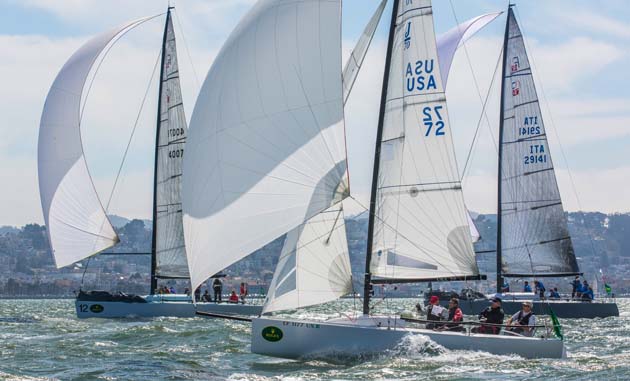Olympian and pro tactician Alain Sign shares his guide to asymmetric spinnaker handling and his speed tips with Andy Rice
One of the most significant advantages of racing with asymmetric kites is the simplicity of asymmetric spinnaker handling compared with symmetrical spinnakers.
But the finer details of how to get the best out of the gennaker are quite subtle and take some practice and coordination between the whole crew, particularly the communications and understanding between kite trimmer, helmsman, mainsail trimmer and the foredeck crew.
In the tightly fought Cape 31 circuit, semi-pro teams are looking for every tiny advantage on the race track. Here are five great tips from Alain Sign for how to find that extra edge on the downwind, whether in marginal planing conditions or full-power.
Select your sails
In the Cape 31 we’re limited to carrying two spinnakers during racing, but even if you have unlimited choice, make sure to check the weather forecast before you head out for racing. If it’s a variable day, try to work out the gust-to-lull ratio. Set up the boat for the most likely choice based on the prevailing conditions, and have the next most likely choice within easy reach in case you need to make a rapid change.
Make sure the other sail is ready to be plugged in and has a drop-line ready to go, so that you can get your bow person prepped to switch it over during the upwind leg if the conditions change significantly for the next downwind.
Article continues below…
Downwind mode
When you come around the windward mark you should know your polars well enough to gauge whether or not to promote planing. You’ve got a target wind speed, boat speed and steering angle you’re looking to achieve.
But as soon as you’re around other boats, you’re not necessarily able to sail to your ideal numbers. Instead, ask yourself what you want to achieve tactically. Do I want to try and soak inside them and stay low? Or do I want to go planing and try and push over and in front of them?
On the Cape 31 if we’re going for a low soak mode, we get the jib down and use crew weight to heel the boat more to windward for better projected area from the spinnaker. If we’re going for planing then we’ll keep the jib up for the extra drive, and get ready to shift the crew weight aft once we’re up on the plane.
Over- or undertake?
Talking of overtaking or ‘undertaking’ the boats around you, it’s important to understand the course axis of the downwind leg. If you’ve got a downwind leg with a long starboard, for example in a round-the-cans race during Cowes Week, it’s going to be beneficial to push high and work your way over the top of the opposition.
But if you’re on a shorter windward-leeward course and not much time remaining on starboard, you want to try to work your way down to a lower line than the boat in front so you can control the gybe.
Once you’ve gybed, you may want to change mode and aim to get planing, depending on how your tactical situation is developing. Getting an early grasp of the course axis in conjunction with the weather forecast will also help you make those critical choices about which kite to use for which leg of the course.

Plane early
Getting yourself planing before everyone else is one of the key skills in marginal planing conditions. Making that early transition can give you a massive advantage, but trying and then not succeeding can end up being an expensive giveaway of time and distance. Block out some time in your training schedule to get the whole team working on how to get the boat on to the plane.
While the general wisdom about trimming an asymmetric is to keep the luff constantly on the curl, it’s not quite as straightforward as that. Hold on to the luff a bit more than normal, because every time you trim the kite sheet in or out, it’s loading or unloading the rudder. So maintain a slight bit of oversheeting to keep the rudder load constant until the boat is successfully up on the plane.
Faster is better
Once it’s a bit windier shift your ‘default setting’ from soaking to planing. There are certain conditions where it’s safer to go faster, for example when it’s blowing a constant 18 knots. At this point soaking can be more hazardous as the apparent wind is coming from further aft which makes the boat quite unstable and can really load up the rudder. Instead you want to bring the apparent wind further forward, over your shoulder at about one or two o’clock so you’ve got less to deal with when problems come up like a side wave hitting the boat.
 If you enjoyed this….
If you enjoyed this….
Yachting World is the world’s leading magazine for bluewater cruisers and offshore sailors. Every month we have inspirational adventures and practical features to help you realise your sailing dreams.Build your knowledge with a subscription delivered to your door. See our latest offers and save at least 30% off the cover price.





